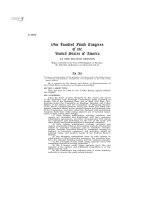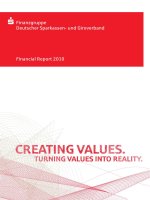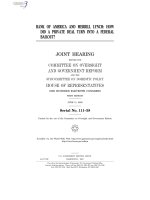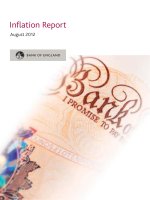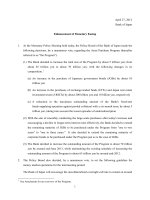Bank of America Environmental Progress Report 2010 potx
Bạn đang xem bản rút gọn của tài liệu. Xem và tải ngay bản đầy đủ của tài liệu tại đây (2.01 MB, 18 trang )
Bank of America
Environmental Progress Report
2010
Our 10-year, $20 billion commitment is addressing climate change and helping to set opportunity in motion.
As one of the world’s largest nancial institutions, Bank of America
understands the powerful role it can play in addressing the private-
sector nancing and economies of scale needed to build a low-
carbon economy. That’s why we have made commitments to align
our nancial products and services to the burgeoning market for
low-carbon energy, including wind, solar, biomass, nuclear and other
emerging technologies. Our goal is to serve all customer audiences
— from large corporate clients and institutional investors to
individual consumers and small businesses. That’s the cornerstone
of Bank of America’s environmental strategy. At the same time, we
have taken measurable action to reduce the environmental impact
of our own operations, an effort that encompasses the ongoing
integration of Merrill Lynch. We’re helping communities by building
environmentally sustainable affordable housing and making schools
and government buildings more energy efcient. We are also
advancing the important work of environmental groups by providing
direct philanthropic support.
Our stakeholders should know that our environmental business
initiative is a program of continuous improvement. There is much
we have done. But we also know there is much more we can do.
Readers will nd examples of both in this report, a reection of
our commitment to transparency in reporting on our environmental
policies, practices and initiatives. We’re excited to tell our story,
because we know the transition to renewable and low-carbon energy
can drive global economic recovery by creating new businesses,
technologies and jobs.
This report is intended to provide stakeholders — clients,
customers, non-governmental organizations (NGO’s), associates and
all those concerned about global climate change — with an update
on our progress toward our goals and commitments. We view it as
a bridge between our most recent Global Reporting Initiative (GRI)
report, published in 2009, which includes environmental initiatives
from 2007 and 2008, and a comprehensive Bank of America
corporate social responsibility report planned for 2011, which will
also adhere to the GRI reporting framework.
We include detailed updates on Bank of America’s environmental
business initiative, a 10-year, $20 billion commitment to address
global climate change, primarily through lending, investing,
products and services and our own operations. Some of these
accomplishments have been reported as part of Bank of America’s
Lending & Investing Initiative, a quarterly update on 10 key areas
in which the bank is helping to drive economic recovery and
community revitalization. Other initiatives are disclosed publicly in
this report for the rst time.
This report is not intended to be a comprehensive compilation
of all of Bank of America’s environmental data and projects. The
transactions, partnerships, products, services and data on the
pages ahead are meant to be representative and illustrative, not
exhaustive. For those interested in greater detail about our various
environmental initiatives, we encourage you to visit page 15 of this
report, which includes links to additional sources.
ABOUT THIS REPORT
Bank of America Environmental Progress Report
Executive Message
|
PAGE 1
For more than two decades, Bank of America has aspired to environmental leadership in the nancial
services sector. In 2007, we announced a 10-year, $20 billion business initiative to address climate
change through our lending, investing, products and services, and our own operations. This initiative
is far more than doing good for its own sake — it has proven to be a long-term, compelling business
opportunity for our clients, our company and our shareholders.
Three years later, Bank of America has delivered tangible results that will have lasting effects on the
communities and clients we serve. I am pleased to report that as of the second quarter of 2010,
we are exceeding our targets. We have completed $8.4 billion toward our $20 billion environmental
commitment, including $5.4 billion in lending and investing activities and facilitating nearly $3 billion
in capital markets activity.
This report documents some of our successes to date. Highlights of our achievements include:
• In 2004, we committed to reduce our total greenhouse gas emissions by 9 percent by
the end of 2009. We achieved double that goal by improving the energy efciency of our
new ofce construction, retrotting existing structures and reducing our ofce space.
• On behalf of our institutional clients, we have provided industry-leading carbon trading services
and offered advice on more than $2 billion in low-carbon energy mergers, acquisition and
other nancial transactions on behalf of both large and small renewable energy companies.
• In the spring of 2010, we opened The Bank of America Tower at One Bryant Park, a landmark
property on the New York City skyline and the rst commercial high-rise in U.S. history to
achieve LEED® (Leadership in Energy and Environmental Design) Platinum certication from
the U.S. Green Building Council (USGBC). A few weeks later, we opened 1 Bank of America
Center in Charlotte, N.C., for which we are currently seeking LEED Gold certication.
At Bank of America, we are helping to create a more sustainable economy for future generations.
I ask you to read this report in the spirit in which it is offered: as yet another example of our
renewed and invigorated commitment to clarity, transparency and fairness in everything we do.
BRIAN T. MOYNIHAN
President and
Chief Executive Ofcer
Bank of America
EXECUTIVE MESSAGE
This business initiative is
far more than doing good
for its own sake — it has
proven to be a long-term,
compelling business
opportunity for our clients,
our company and our
shareholders.
“
”
We have completed $8.4 billion toward our $20 billion environmental commitment, committing
$5.4 billion in lending and investing activities and facilitating nearly $3 billion in capital
markets activity.
Bank of America Environmental Progress Report
Financing a Low-Carbon Economy
|
PAGE 2
FINANCING A LOW-CARBON ECONOMY:
Setting Opportunity in Motion
The transition to a low-carbon economy is a complex endeavor that requires choices and
actions by us all — individuals, communities, businesses, governments and non-governmental
organizations (NGOs).
Financial institutions, with
their capacity to nance
growth and innovation, can
and will play a critical role
in this transition. At Bank
of America, we understand
that the intellectual and
nancial capital that must be
mobilized to implement and
commercialize low-carbon energy generation can set opportunity
in motion by creating new businesses, technologies and jobs and
creating healthier communities. As an international enterprise, we
have the depth of expertise, resources and global reach to nance
companies and developers, support our clients’ energy initiatives
and create market mechanisms that help drive investment ows
toward low-carbon energy activities.
Bank of America’s 10-year, $20 billion environmental business
initiative was designed to be a catalyst for an acceleration of
low-carbon activities across the markets we serve. Our strategy is
to put our capital, capabilities and associates to work on behalf
of clients and customers across the business continuum. This
includes companies that require strategic investments or access
to capital markets to develop and commercialize innovative energy
technology; commercial real estate developers and businesses
seeking loans to nance energy-efcient expansion; larger
enterprises where the leasing of energy-saving equipment can
provide a cost-effective way to become more efcient or utilize
renewable sources of energy; and investors seeking guidance on
emerging opportunities in the alternative energy sector.
By the middle of 2010, we had delivered $8.4 billion toward our
$20 billion goal, a pace that puts us well ahead of our 10-year
plan. Our progress to date demonstrates the multiple ways that
our company is helping to address climate change, including
Investment Banking ($2.8 billion), Commercial Real Estate Banking
($2.8 billion), Leasing ($2.2 billion), Strategic Environmental
Investments ($265 million), Commodities ($102 million),
Philanthropy ($21 million) and our own Corporate Workplace
initiative ($233 million). Here are recent examples of how
Bank of America is working to help clients reduce greenhouse
gas (GHG) emissions.
Energy Efciency
Bank of America provides nancing for a wide range of construction
projects and facility improvements that enhance the energy
efciency of newly constructed and existing commercial buildings,
federal, state and local government buildings, hospitals and schools.
Leasing: In Washington, D.C., for example, the U.S. Capitol building
is being retrotted with lighting, heating and cooling equipment
nanced by a Bank of America subsidiary through its client,
Bank of America Environmental Progress Report
Financing a Low-Carbon Economy
|
PAGE 3
Ameresco Inc., a company that designs and installs solutions to cut
energy and maintenance costs for a customer base comprised largely
of federal, state and local governments in North America.
The iconic two-century-old Capitol Hill landmark operates under the
jurisdiction of the Architect of the Capitol, the agency responsible for
historical preservation and incorporating energy-efciency features.
Once the new equipment nanced by the bank is installed and
operational, annual energy savings are expected to reach 4,637
megawatt hours of electricity and 107,587 million BTUs (British
thermal units) of steam and chilled water energy. In the rst full
year alone, the nancial savings from this initiative are projected
to be $2.3 million. Bank of America had previously worked with the
Architect of the Capitol and Ameresco to provide nancing for energy
conservation measures at three other Capitol Hill locations.
Investment Banking: Bank of America Merrill Lynch was also the sole
bookrunner on Ameresco’s initial public offering, one of the most
prominent clean energy IPOs of 2010. The transaction creates the
rst publicly-traded company focused exclusively on energy efciency,
a fast growing renewable energy sub-industry expected to reach $500
billion in market size by 2020 in the U.S. alone.
Commercial Real Estate: Bank of America closed a $27.5 million loan
to the Aventura, Fla based Trump Group to build the largest industrial
facility in the U.S. The 1.8 million square-foot project, located in
Riverside County, Calif., will allow a popular footwear manufacturer
to consolidate several of its Southern California factories into
one location. Once complete, the builders will seek LEED® Silver
certication from the USGBC for features that include such energy-
efcient design elements as solar power, water conservation and
reduced energy consumption through natural lighting, ventilation
and specialized water quality and storm water programs. The project
is expected to create more than 3,000 construction, hourly and
permanent jobs.
Renewable Energy
Bank of America has increased its focus on investing in and nancing
the development and use of cleaner renewable energies. Recent
examples include:
Solar
• Bank of America’s renewable energy
nance team arranged the nancing
for a $23.9 million lease to a major
solar company for the installation of
photovoltaic solar power generation
systems at seven Walmart and Sam’s
Club retail locations in Southern
California. The photovoltaic systems
provide enough power to meet up to 30 percent of each location’s
energy needs. The solar leasing deal helps advance Walmart’s
commitment to supply its stores with 100 percent renewable
energy.
• Bank of America Merrill Lynch acted as nancial advisor to
Acciona, S.A. on the sale of a 34 percent stake in a Portuguese
photovoltaic power plant, Amper Central Solar, to Mitsubishi
Corp. Based in Madrid, Spain, Acciona is a global leader in
renewable energy, water services and infrastructure solutions.
This transaction was the cornerstone of an agreement between
Acciona and Mitsubishi to develop and operate renewable energy
projects, with a targeted investment of €2 billion.
Wind
• Bank of America provided $43.6 million in tax equity to Peace
Garden Wind Funding, a new wind power tax equity partnership
managed by NextEra Energy Resources, the largest North
American generator of renewable wind and solar energy. Peace
Bank of America Environmental Progress Report
Financing a Low-Carbon Economy
|
PAGE 4
$20 Billion Commitment Progress
Commercial Real Estate Banking (CREB): nances projects with
LEED® certication, ENERGY STAR, Browneld redevelopment and use
of renewable energy tax credits
Global Investment Banking (GIB): facilitates capital ows to clients
developing and adopting low-carbon technologies
Leasing: nances utility-scale renewable energy projects
Strategic Environmental Investments (SEI): places private equity in
renewable energy companies
Corporate Workplace (CW): invests in energy efciency initiatives in
company facilities and LEED certication in all new construction of
banking centers and ofces
Commodities: invests in carbon risk management and markets
Philanthropy: supports nonprots focused on climate change
Garden Wind consists of two wind
farms in North Dakota capable of
generating sufcient power to serve
more than 55,000 homes in that
and nearby states.
Biomass
• The Savannah River Site (SRS),
located near Aiken, S.C., is a top research hub for
scientists and engineers working on new solutions in global
energy. Bank of America provided $70 million in nancing
to fund a project that includes a cogeneration facility and two
smaller biomass heating facilities that are primarily fueled with
byproducts from timber harvesting. Under the U.S. Department of
Energy’s largest-ever Energy Savings Performance Contract, the
agency contracted with Ameresco Federal Solutions to design,
construct, operate, maintain and fuel the new biomass facility
over a 20-year period. The new biomass project replaces a
deteriorating, inefcient coal power plant and oil-red boilers at a
savings of approximately $35 million a year in energy, operational
and maintenance costs, and reduces air-borne pollutants,
including 100,000 tons per year of GHG emissions.
*March 2007 – June 2010
Leasing ($2.2B)
CREB ($2.8B)
GIB ($2.8B)
Philanthropy ($21M)
Commodities ($102M)
CW ($233M)
SEI ($265M)
Bank of America Environmental Progress Report
Financing a Low-Carbon Economy
|
PAGE 5
Biofuel
• Bank of America led a $103 million private placement to fund a
cogeneration plant for Shree Renuka Sugars, one of the largest
producers and marketers of sugar-based ethanol in India. The
plant will produce power from a sugar byproduct, bagasse, for
captive consumption and sale to the state electrical grid. The
residue from these operations can also be used to produce
bio-fertilizers.
Carbon Market Services
Bank of America Merrill Lynch operates an active carbon market
services business that provides risk management, market access
and liquidity, and structured nance to a variety of corporate
clients looking to offset carbon emissions or manage their
carbon exposure.
In 2008, we engineered a ground-breaking transaction to
preserve a 750,000-hectare refuge in the Aceh province of
Indonesia, an ecologically sensitive region recovering from the
Indian Ocean tsunami of 2004. A partnership was formed with
Carbon Conservation, an Australian company, to monetize carbon
credits generated by a commitment to preserve the rainforest
in perpetuity. The transaction will generate income for the
indigenous people who depend upon the forest for their livelihood,
in addition to protecting a habitat for endangered Sumatran
rhinoceros, tigers, orangutans, elephants and clouded leopards.
More recently, Bank of America Merrill Lynch facilitated a carbon
credit agreement with four Chinese wind farms located in the
Shandong, Hebei and the Inner Mongolia provinces of China,
owned by Guohua Energy Investment Company, a subsidiary of
China Shenhua Energy Company, the largest coal mining enterprise
in the country. The wind farms, operational since 2009, have
been registered with the United Nations and have the ability
to generate more than 1.5 million carbon credits by 2012.
The bank also purchased carbon credits and acted as a carbon
monetization agent for the International Bank for Reconstruction
and Development, a division of the World Bank, which in its role as
Trustee of the Adaptation Fund is helping to generate nancing for
countries most vulnerable to climate change.
Helping Consumers Reduce Their Carbon Footprint
Bank of America offers products and services that enable consumers to reduce
their environmental footprint and support the work of leading environmental
organizations.
• We offer customers a range of options for “e-delivery.” Through Online Banking
and Bill Pay, e-statements, deposit image ATMs and other products, the bank
is working with customers to signicantly reduce overall paper consumption.
E-delivery reduces paper usage, cuts cost to the bank and provides
customers more ways to protect their privacy. In April 2010, Bank of America
reported a 38 percent increase in the number of paper account-related
communications suppressed through digital delivery. With the complete
upgrade of more than 13,800 deposit-image ATMs, which no longer require
envelopes for deposits, we eliminated the use of more than 2.2 million
pounds of paper in 2009.
• Brighter Planet™ Afnity Banking offers credit and debit cards that help
customers nance community-based renewable energy projects. To date,
more than 150,000 Bank of America Brighter Planet customers have helped
fund the construction of 19 community renewable energy projects in the U.S.,
preventing the release of more than 200 million pounds of carbon dioxide
into the atmosphere as of June 2010.
• We have partnered with several environmental groups to offer Afnity Banking
products in which a customer’s preferred organization receives a contribution
with each qualied purchase.
• Bank of America currently offers two green mortgages to customers. With
the Energy Credit Mortgage, homebuyers can receive up to a $1,000 credit
for each home-purchase meeting Energy Star specications. The Energy
Efciency Mortgage allows borrowers to nance energy-efcient home
improvement by adding the costs of the improvements to their home loan.
Bank of America Environmental Progress Report
Reducing Our Environmental Footprint
|
PAGE 6
REDUCING OUR ENVIRONMENTAL FOOTPRINT
As an industry, banking has a smaller environmental footprint than such sectors as manufacturing,
mining or energy. But it would be a mistake to say the footprint of the nancial services industry
is small.
At Bank of America, we have nearly
300,000 associates working in
more than 40 countries. Globally, we
occupy 123.6 million square feet of
space, including more than 6,000
banking centers in the U.S. alone.
Each day, our operations consume
10 million gallons of water and result
in more than 5,000 tons of GHG
emissions, not including the impact
of associates’ daily commute and
business travel.
The sheer scale that gives us the
potential to play a part in nancing
the transition to a low-carbon economy has its counterpart in the
environmental impact of our operations and our supply chain.
That’s why Bank of America has developed a comprehensive
approach to managing our own emissions and reducing our
environmental footprint. Our efforts encompass: 1) our operations
2) our associates and 3) our supply chain.
Our Operations
In 2004, Bank of America joined with other members of the U.S.
Environmental Protection Agency’s Climate Leaders program to
reduce our GHG emissions by 9 percent by the end of 2009. Within
ve years, we have surpassed this, achieving reductions of 18
percent, or double our initial commitment from a 2004 baseline.
Now, the addition of two signicant businesses — Merrill Lynch and
Countrywide — compels us to create a fresh baseline upon which
to measure our progress on GHG reductions going forward. We are
currently developing specic goals for future years.
Energy efciency initiatives account for the most signicant
reductions in Bank of America’s GHG emissions. Over the past
three years, we have invested more than $150 million in energy
conservation measures, such as energy-efcient lighting and HVAC
systems, for our facilities. Our Corporate Workplace Intelligent
Command Control Center (iC3), which centralizes the monitoring
and control of energy usage in buildings across our portfolio,
reduces not only emissions but costs: we’ve saved more than
$100 million since 2004.
Bank of America’s focus on energy efciency includes a
commitment to build all new banking centers to meet LEED®
standards. Our commitment to achieve LEED certication for new
construction totals $1.4 billion over 10 years.
Bank of America now occupies more than 10 million square
feet certied under the LEED Rating System, including LEED for
New Construction, LEED for Core & Shell and LEED for Existing
Buildings. One notable success is The Bank of America Tower at
One Bryant Park in New York City, which recently achieved LEED
1 Bank of America Center
Charlotte, N.C.
Bank of America Environmental Progress Report
Reducing Our Environmental Footprint
|
PAGE 7
Platinum certication, marking the rst
time in U.S. history that a commercial
high-rise ofce building attained the
highest LEED Green Building Rating
for environmental performance and
sustainability.
The tower has been designed to
reduce peak daytime energy demand
30 percent by utilizing a wide range
of high-performance environmental
technologies. A highly efcient on-
site cogeneration plant will provide
nearly two-thirds of the tower’s annual
electricity requirements. Water-saving
strategies, including systems that
capture and use nearly all of the rain
that falls on the rooftop, save more
than 7 million gallons of water a year,
a nearly 50 percent reduction. In June
2010, the tower received the Council on
Tall Buildings and Urban Habitat 2010 Best Tall Building Award for
the Americas region.
We are currently pursuing LEED Gold certication on the newly
completed 1 Bank of America Center, a 30-story, 750,000-square
foot ofce building in Charlotte, N.C. The building incorporates
sustainable construction features including rainwater and
groundwater collection; low water-ow xtures; bike racks, showers
and changing space, so associates can cycle to the ofce; and
ofces and meeting spaces illuminated by natural light. In just one
year, these features will save enough energy to power 260 homes
and save more than 3.3 million gallons of water.
The Bank of America Corporate Center, our headquarters building in
Charlotte, was completed in 1992 and achieved LEED for Existing
Buildings certication in 2010.
In addition to raising the efciency of the space we occupy, space
reduction provides another path to lowering our GHG emissions. In
2010, we will eliminate 6.4 million square feet of commercial ofce
space. We have plans to further reduce our occupied space by 16
million square feet by the end of 2013.
Our Associates
At Bank of America, we recognize that our associates can make
a signicant impact, individually and together. Our new Make an
Impact program, developed in partnership with the Pew Center
for Global Climate Change, encourages associates to reduce
their own carbon emissions through a series of interactive in-
person educational workshops, grassroots activities, a dedicated
website and a carbon calculator. This multi-channel approach gives
associates tools to set personal
reduction goals, measure their
carbon footprint, track their progress,
and encourage coworkers, family and
friends to participate. The added
benet is that Bank of America can
measure and monitor progress on
energy use and emissions reduction
across our associate base.
Bank of America offers other programs to help associates
minimize their carbon footprint. Our hybrid vehicle reimbursement
program, launched in 2007, reimburses associates $3,000 when
they purchase a new hybrid vehicle. To date, more than 3,000
associates have traded in conventionally powered vehicles for
hybrids that on average doubled their fuel economy to 40 miles
per gallon and avoided nearly 4,000 tons of CO
2
emissions. The
overwhelming majority of participants — 94 percent — tell us the
program inuenced their car-buying decision. In 2010, we expanded
the program to include highway-capable electric vehicles and
compressed natural gas vehicles.
Bank of America Tower at One
Bryant Park, New York, N.Y.
Make an Impact Associate Event,
Newark, N.J.
Bank of America Environmental Progress Report
Reducing Our Environmental Footprint
|
PAGE 8
Our Supply Chain
Bank of America understands that our global scale provides
us with signicant opportunities to encourage our suppliers to
increase their focus on climate change and resource efciency.
In June 2010, we held our Global Supply Chain Conference,
a two-day event attended by approximately 100 suppliers.
Conference representatives were strongly encouraged to
Emissions Source
Emissions (metric tons CO
2
e)
% of
Total
U.S. International Total
Scope 1 Emissions
Stationary Combustion 96,363 9,414 105,776 4%
Mobile Combustion 9,994 0 9,994 0.4%
Refrigeration 18,364 0 18,364 0.7%
Other Fugitive 166 0 166 0.0%
Subtotal 124,887 9,414 134,301 5%
Scope 2 Emissions
Electricity 1,735,243 138,795 1,874,038 67%
Steam 13,613 0 13,613 0.5%
Chilled Water 1,667 0 1,667 0.1%
Subtotal 1,750,523 138,795 1,889,319 67%
Scope 3 Emissions
Commuting 591,779 51,935 643,714 23%
Air Travel 98,540 41,860 140,399 5%
Contractor Vehicles 6,131 0 6,131 0.2%
Subtotal 696,449 93,795 790,244 28%
Total Emissions 2,571,860 242,004 2,813,864
Reductions from Green Power 15,340 0 15,340
Net Emissions 2,556,520 242,004 2,798,524
U.S. totals in blue are based on reporting to EPA Climate Leaders.
International totals are based on best available data and estimates, and will be rened in future years.
2009 Bank of America Emissions Data
participate in the Carbon Disclosure Project’s comprehensive
emissions reporting program. Our long-range goal is to build
awareness of Bank of America’s sustainable supply chain
management priorities and encourage suppliers to take additional
steps to address GHG emissions in their own business activities.
Bank of America Environmental Progress Report
Building Environmentally Healthy Communities
|
PAGE 9
BUILDING ENVIRONMENTALLY HEALTHY COMMUNITIES
Recognizing that the health of our company is dependent on the health of the communities
we serve, the Bank of America Charitable Foundation will donate $50 million over 10 years to
support nonprot organizations focused on addressing climate change.
In addition, as part of our $20
billion environmental business
initiative, and the bank’s
broader focus on community
development, Bank of America
provides nancing for energy
retrotting and developing green
affordable housing and schools.
Taken together, our philanthropic
and commercial community-
based activities are intended
to promote the transition to a low-carbon economy — improving
the environmental health of communities while furthering green
workforce development and training.
Below are some recent examples.
Green Affordable Housing
Bank of America has a long history of funding green affordable
housing, which not only helps improve the health of the residents,
but makes the cost of living in the home more affordable. Recent
projects include:
• Financing the preservation and renovation of Walnut Park
Apartments, a 38-unit complex in Portland, Ore. that is home to
seniors who live on xed incomes. In partnership with REACH
Community Development and other community-based
organizations, Bank of America provided more than $7 million
in nancing for the renovation, which includes sustainability
updates to improve indoor air and water quality. Energy
improvements will save an estimated
100,000 kilowatt hours in the rst year
alone.
• Financing the development of 42
housing units for low-to-moderate
income seniors in Cherry Gardens, the
oldest African-American community in
Charlotte, N.C. We invested $2.8 in
the $6 million development, which will
be the rst LEED®-certied affordable
housing project in North Carolina.
• Funding the rst affordable housing development with a LEED
Gold certication in the state of Texas, with a LEED Platinum
application pending. The Metro Station Apartments is a 150-
unit family complex
located along Austin’s
commuter light rail
system. To be completed
in 2011, the development
will provide homes for
low-income families and
individuals.
Cherry Gardens,
Charlotte, N.C.
Metro Station Apartments,
Austin, Texas
International Coastal Cleanup,
Washington, D.C.
Bank of America Environmental Progress Report
Building Environmentally Healthy Communities
|
PAGE 10
• Providing Concern for Independent Living, LLC with nearly
$17 million in new credit and equity nancing to redevelop
a browneld site in Brooklyn, N.Y. The project included the
rehabilitation of a former hospital
built in 1913. Once complete,
the 51,000-square-foot, 65-unit
facility will provide supportive
affordable housing for mentally
challenged individuals at high risk
of homelessness. Twenty units
have been reserved for those
formerly homeless. On-site case
management and nonmedical assistance with daily living skills
will be provided to residents.
The bank was a founding partner of Enterprise Community
Partners’ Green Communities initiative, which is re-thinking how the
affordable housing sector designs, locates and builds affordable
housing across the country. More recently, the bank partnered
with the USGBC to form the Affordable Green Neighborhoods
program that will provide educational resources to affordable
housing developers and related public agencies pursuing LEED
for Neighborhood Development certication. The program focuses
on redeveloping previously developed sites, undertaking efforts to
strengthen surrounding neighborhoods, engaging stakeholders in
the development process, and providing green housing for a wide
range of income levels.
Environmental Philanthropy and Volunteerism
Bank of America builds strong partnerships with individuals,
nonprot organizations, leading academic institutions and other
businesses to pursue and achieve shared environmental goals.
Through our partnerships and alliances, we draw upon a wider set
of experiences, help foster communication among stakeholders and
learn more about the markets, clients and communities we serve.
Recent examples of our environmentally focused philanthropic and
volunteer efforts include:
• Bringing together the National Wildlife
Federation, a leading conservation
organization, and Jobs for the Future,
a national leader in workforce
development, to create a pilot program
to help community colleges build
local green jobs partnerships among
green-sector employers, workforce
development organizations, unions and
other community stakeholders. The two-
year pilot includes technical assistance,
an extensive series of workshops through community college
systems in several regions across the U.S., and an online best
practices center with a mix of web resources, reports, model
training and retraining programs.
• Supporting Ocean Conservancy’s International Coastal
Cleanup, the largest volunteer event of its kind focused on
addressing environmental concerns by removing debris from
the world’s oceans and waterways. In 2009 alone, hundreds
of bank associates rolled up their sleeves and contributed to
the removal of more than 7.4 million pounds of trash in 108
countries and locations across 45 U.S. states.
• In the U.K., we are working alongside two local NGO’s on two
projects: the Climate Squad and the Waterways Action Squad,
both of which are aimed at encouraging young people aged 16
to 25 to engage in environmental volunteering activities across
the country.
Concern Rochester Apartments,
Brooklyn, N.Y.
Earth Day Volunteer Event
Lake Mead, Las Vegas, Nev.
Bank of America Environmental Progress Report
Our Environmental Policies and Practices
|
PAGE 11
OUR ENVIRONMENTAL POLICIES AND PRACTICES
At Bank of America, we recognize that an effective environmental program requires the
development of and adherence to concrete policies and practices.
We further recognize that as one
of the largest nancial institutions
in the world, we may consider
nancing transactions on behalf
of clients and customers that,
while providing the raw materials
and energy that power economic
growth, may have a signicant
impact on the environment. When
considering such transactions, our business focus is to help our
clients minimize the adverse impacts of their operations. Our credit
policies incorporate an environmental due diligence process, in
addition to comprehensive evaluations conducted by consultants
and other outside experts. When working with clients that operate
in emission-intensive sectors, we apply our risk and underwriting
processes and standards to factor in the projected cost of potential
environmental and GHG emissions regulations.
Forests Policy
Bank of America recognizes that the sustainable management
of forests is a vital component in our society’s ongoing effort to
mitigate the impact of climate change. We are strong advocates
of sustainable forestry investments and have consistently applied
our industry’s highest standards to our lending, investing and
underwriting activities, as well as to our own operations.
Forest Lending
Our forest lending policy stresses the importance of the attainment
by our customers and clients of veriable third-party forestry
certication, by incorporating this requirement as a key element
of our due diligence process. Our forest lending policy specically
states that we will take all practical
measures to assure that lending
proceeds are not used to nance
commercial projects or operations that
result in resource extraction from or the
clearing of primary forests not managed
according to sustainable forestry
practices as veried by an independent
third-party audit and that we will also not nance companies or
projects that collude with, or knowingly purchase timber from, illegal
logging operations; or that do not have an explicit policy in place
against the uncontrolled and/or illegal use of re in their forestry or
plantation operations.
Paper Procurement Policy
Our paper procurement policy contributes to the ecological health
of forests by reinforcing the market for certied forest ber,
by procuring forest products whose ber is third-party certied
according to such credible, independent and widely accepted
standards as the Forest Stewardship Council (FSC) and Sustainable
Forestry Initiative (SFI) standards. Our paper procurement policies
Bank of America Environmental Progress Report
Our Environmental Policies and Practices
|
PAGE 12
mandate the minimal use of paper containing virgin wood ber and
strongly encourage the sourcing of paper from forests that use
environmentally preferable practices and protect environmentally
sensitive areas.
Energy Policy
Our energy policy is intended to encourage the growth of low-carbon
emitting energy sources, such as nuclear power, solar and wind. In
the U.S., we have publicly supported the establishment of a stable
and predictable regulatory environment, preferably including a
legislative or regulatory low-carbon energy framework, which would
create a market-based infrastructure for attracting private capital to
low-carbon investment opportunities. As signatories to The Carbon
Principles, we are committed to assessing the likely cost of carbon
in our risk and underwriting processes.
Coal Policy
Our coal policy promotes the development and deployment of
advanced technologies that reduce carbon emissions through
carbon capture and storage. The policy also recognizes our
adherence to leading risk management tools such as the Carbon
Principles. We have committed to phasing out our nancing
of companies whose predominant method of extracting coal
is through mountain-top removal, a decision that has received
widespread recognition from the environmental community.
Reputational Risk and Corporate Governance
Reputational Risk
Consideration of reputational risk issues is an additional
component of our overall risk management framework. In addition
to ongoing consultation and engagement with a wide variety of
external stakeholders, including NGOs, government agencies, peers
and others, our Public Policy Team, Global Environmental Group and
business lines all regard reputational risk as a critical component
of our risk management framework. In addition, a senior manager
from our Global Risk Management Group sits on our Environmental
Council.
Corporate Governance
Bank of America’s lines of business are the primary drivers of
our environmental business initiative. To monitor, encourage and
facilitate the development of products, practices and policies
aligned with our 10-year, $20 billion environmental commitment,
we established an Environmental Council currently chaired by
our Chief Global Strategy and Marketing Ofcer, who reports
directly to the CEO on all environmental issues. The Council is
comprised of business heads and senior leaders from across our
business and corporate groups, including retail, corporate and
investment banking, wealth management, research, marketing
and communications, risk management, public policy, technology,
operations and philanthropy. The Council is, in turn, supported
by our Global Environmental Group, reporting to the Global
Environmental Executive, who serves as the primary integration
point for all of our environmental business activities.
Bank of America Environmental Progress Report
The Challenge Ahead
|
PAGE 13
THE CHALLENGE AHEAD
As a committed proponent of market-based solutions to addressing global climate change,
we recognize that the most fundamental challenge we face as a company and as an industry
is that the global market for low-carbon energy and energy efciency remains immature and
underdeveloped.
Until a strong regulatory framework with linked international
markets effectively puts a price on carbon emissions, the transition
to a low-carbon economy will be slow.
Government and regulatory actions aside, we recognize that the
nancial services sector has a critical long-term role to play in
working with clients and customers to help them more clearly
comprehend the risks, uncertainties and also the opportunities
inherent in low-carbon energy and energy efciency. Here are some
examples of these challenges:
• Enhancing Environmental Products & Services
On the consumer products front, we still have a long way to go
— as a company and as an industry — in providing consumer
products that will comprise a true market for environmental
goods and services. Like other nancial companies, Bank of
America has produced environmentally oriented credit cards
and mortgage products. But for a variety of reasons, these
products have yet to gain traction with a critical mass of
customers and clients.
On the investor front, while we have seen an increase in
interest for low-carbon or socially responsible investment (SRI)
activity on the part of both individual and institutional clients,
we recognize the need to continuously improve and rene our
research, insights and guidance to support those investors
interested in rebalancing or re-weighting their portfolios to take
advantage of these emerging themes.
On the institutional front, many clients still need to be
appraised of the broad business case for making signicant
investments in the development of a low-carbon economy. For
investors, regulatory and technology uncertainty is seen to be
impacting the ability to accurately estimate certain long term
investment returns, and it’s important for our industry to work
closely with all involved to drive greater clarity where possible.
Addressing climate change will require the involvement of all
industry sectors, and despite the size of some of the upfront
costs of investment, or the potentially prolonged horizon for
investment returns, we need to nd improved mechanisms and
approaches to catalyze investment on a broader scale.
• Measuring Business Impacts
As an industry, we need to do a better job of understanding the
measurement of our business impacts related to emissions.
This involves moving beyond measuring and managing
direct GHG emissions attributed to energy use. We must
also understand the embedded impacts of all our employee
activities, including air travel and commuting, as well as the
impacts of our partners in the supply chain. In the case of our
suppliers, while we are aware that we can be a catalyst for
change, we are just starting out on the path to using our scale
and inuence to collaborate with our supply chain partners
to optimize energy efciency and minimize our collective
environmental impact.
Bank of America Environmental Progress Report
The Challenge Ahead
|
PAGE 14
• Stakeholder Relationships
Our stakeholders include customers that operate in impactful
areas such as the power sector, manufacturing and mining.
Our challenge is to engage stakeholders in a way that strikes
an appropriate balance between our roles as a client service
provider and collaborator with our responsibility as a policy
advocate for market-based solutions that address climate
change. We are well positioned to fulll this role by convening
policy makers and other thought leaders on the most efcient
and business-focused climate and energy solutions from
sectors that have the most at stake in terms of opportunities
and impacts.
|
PAGE 15
• Bank of America Environmental Website:
/>• Bank of America Annual Reports:
/>zhtml?c=71595&p=irol-reportsannual
• Quarterly Lending and Investment Reports:
Previously Published GRI Reports:
/>2008_GRI_Report.pdf
/>Reporting_Initiative_Report.pdf
• Bank of America News Releases:
/>zhtml?c=234503&p=irol-news&nyo=0
• Climate Change Policies, including Carbon Principles:
/>jsp?articleId=Climate-Change
• Credit Policies:
/>jsp?articleId=Credit-Policies
• Utility Portfolio Emissions: page 32
/>2008_GRI_Report.pdf
• Forests Policy:
/>jsp?articleId=FORESTS-PRACTICES
• Paper Procurement Policy:
/>Procurement_Policy.pdf
• Forest Certication Policy:
/>Certication.pdf
• Energy Policy:
/>jsp?articleId=Energy
• Coal Policy:
/>POLICY.pdf
• The Equator Principles:
/>Principles.pdf
• Developing Countries Lending Criteria: 2007/2008 GRI
Sustainability Report: page 60
/>2008_GRI_Report.pdf
FOR MORE INFORMATION
For more information about Bank of America and its environmental business initiative please visit:
Bank of America, Member N.A. FDIC. © 2010 Bank of America Corporation. Printed on 30% post consumer recycled paper.
08/2010
RPT-06-10-0774



